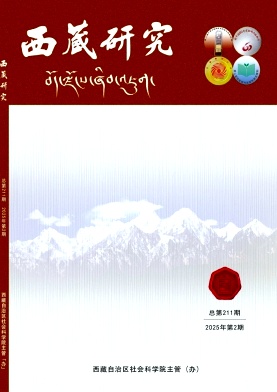| 633 | 12 | 14 |
| 下载次数 | 被引频次 | 阅读次数 |
随着吐蕃考古工作的不断深入,作为镇墓兽的石狮发现量有所增加。有的石狮目前虽流落他处,但相关资料表明可能出自各大墓地。日渐多样的石狮形态很难用以往惯用的固定称谓来进行归纳。究其原因,不仅是吐蕃与周边崇尚狮子的诸多国家地区互为频繁交流的体现,也与石狮制作的年代先后相关联。西藏佛教后弘期早期狮子文明大规模传入、扎根西藏并与诸狮子文化逐渐融为一体,现不易加以区分。但从早期文献所记文化功能入手可知,诸狮子交融性相对起到返本还原和追根溯源作用。
Abstract:There is a gradual increase of finding tomb stone lions as the Tibetan archaeological work making progress in Tibet. Some of the stone lions are owned by individuals,but relevant document reveals that the stone lions originated from Tibetan Kingdom Tombs. It is difficult to categorize the stone lions according to traditional categorizing as the images of stone lions are diversity. This is due largely to frequent cultural exchange with some other nations and regions that also advocating lion,and the time difference of carving stone lions as well. During the early period of the later spread of Buddhism in Tibet the culture of lion adopted and rooted in Tibet,and the lion culture enriched as a result. However,if merely depend on early record of stone lion culture and its function,the diversity of lion culture traces its original sources.
[1]索朗旺堆,何周德.扎囊县文物志[M].拉萨:西藏自治区文物管理委员会,1986:50.
[2]Tucci,G.1950.The tombs of the Tibetan kings.Roma,ISMEO;王毅.藏王墓——西藏文物见闻记(六)[J].文物,1961(5);Richardson,H.E.1963.Early Burial Grounds in Tibet and Tibetan Decorative Art of the Eighth And Ninth Centurys.CAJ,Ⅷ,2,P.77—79;童恩正.西藏考古综述[J].文物,1985(9);霍巍.试论吐蕃王陵—琼结藏王墓地研究中的几个问题[J].西藏考古,1994(1);汤惠生.略说青海都兰出土的吐蕃石狮[J].考古,2003(12);Heller,A.,2007.Lions and Elephants in Tibet,Eighth to Ninth Centuries,In Journal of Inner Asian Art and Archaeology,vol 2.Lilla Russell-Smith and Judith A.Lerner,eds.Turnhout:Brepols Publishers,p59—67.
[3]西藏文管会文物普查队.西藏拉孜、定日二县古墓群试掘简报[J].南方民族考古(第4辑),1992:105—124;汤惠生.略说青海都兰出土的吐蕃石狮[J].考古,2003(12);霍巍.试论吐蕃王陵——琼结藏王墓地研究中的几个问题[J].西藏考古,1994(1).
[4]巴桑旺堆.墨竹工卡县切卡寺发现两尊拟似吐蕃时期遗存的古石狮[J].2014(3);Hazod,G.,The lions of’Chad kha:A note on new findings of stone monuments in Central Tibet from the Tibetan imperial period.The Illuminating Mirror(Ed.O.Czaja and G.Hazod)Wiesbaden:Ludwig Reichert Verlag.2015,P189—204.
[5]Heller,A.,1998c.“Some Preliminary Remarks on the Excavations at Dulan.”In Orientations 29(9),p84—92;汤惠生.略说青海都兰出土的吐蕃石狮[J].考古,2003(12).
[6]Heller,A.,2006g.“Preliminary Remarks on the Archeological Investigations of Dulan:8th—9th Century Tibetan Tombs?”In Studies in Sino-Tibetan Buddhist Art:Proceedings of the Second International Conference on Tibetan Archaeology and Art,Beijing,September 3-6,2004(汉藏佛教艺术研究:第二届西藏考古与艺术国际学术研讨会论文集).Xie Jisheng,Shen Weirong,Liao Yang,eds(谢继胜,沈卫荣,廖旸主编).Beijing:China Tibetology Publishing House(中国藏学出版社).p57—76;Heller,A.,2007.Lions and Elephants in Tibet,Eighth to Ninth Centuries,In Journal of Inner Asian Art and Archaeology,vol 2.Lilla Russell-Smith and Judith A.Lerner,eds.Turnhout:Brepols Publishers,p.59—67.
[7]Richardson,H.E.,1963.Early Burial Grounds in Tibet and Tibetan Decorative Art of the Eighth And Ninth Centurys,CAJ,Ⅷ,2,P.77—79.
[8]Richardson,H.E.1987.Early Tibetan inscriptions some recent discoveris,Tibet Journal,12.2.P3—15.
[9]童恩正.西藏考古综述[J].文物,1985(9).
[10]汤惠生.略说青海都兰出土的吐蕃石狮[J].考古,2003(12).
[11]Tong Tao.2008.Unpublished thesis:The Silk Roads of the Northern Tibetan Plateau during the Early Middle Ages(from the Han to Tang dynasty)as reconstructed from Archaeological and Writen sources(Tübingen2008)
[12]Heller,A.2007.Lions and Elephants in Tibet,Eighth to Ninth Centuries,In Journal of Inner Asian Art and Archaeology,vol 2.Lilla Russell-Smith and Judith A.Lerner,eds.Turnhout:Brepols Publishers.
[13]霍巍.吐蕃时代考古新发现及其研究[M].北京:科学出版社:2012:51.
[14]Hazod,G.The lions of’Chad kha:A note on new findings of stone monuments in Central Tibet from the Tibetan imperial period.The Illuminating Mirror(Ed.O.Czaja and G.Hazod).Wiesbaden:Ludwig Reichert Verlag.2015,P189—204.
[15]Heller,A.,1998a“Two Inscribed Fabrics and their Historical Context:Some Observations on Esthetics and Silk Trade in Tibet,7th to 9th Century.”In Entlang der Seidenstraβe:Frühmittelalterliche Kunst zwischen Persien und China in der Abegg-Stiftung.Riggisberger Berichte 6.Karel Otavsky,ed.Riggisberg:Abegg-Stiftung,p95-118.
[16](宋)王钦若,等.册府元龟·外臣部·朝贡三[M].北京:中华书局,1989:3864.
[17]沈琍.中国有翼神兽渊源问题探讨[J].美术研究,2007(4).
[18]#12
[19]#12
[20]刘自兵.佛教东传与中国的狮子文化[J].东南文化,2008(3).
[21]Gyurme Dorje,Tashi Tsering,Heather Stoddard.Andre Alexander,2010.JOKHANG.Tibet’s most sacred Buddhist Temple.Edition Hansjorg Mayer,London:174—175.
[22]霍巍.西藏古代墓葬制度史[M].成都:四川人民出版社,1995:154.
(1)且噶石狮当初发现地为且噶寺西南方向约2公里地名为苯巴山墓地大墓两侧,2009年首次被文物工作人员发现时还在山脚下农地里,约2010年移至且噶寺。承蒙夏格旺堆副研究员相告深表感谢!
(2)石狮信息至数据先后由西藏博物馆娘吉加副研究员和日喀则地区博物馆格旺先生提供,在此深表感谢!
(1)承蒙西藏文研所陈祖军研究员相告,在此深表感谢!
(2)遗址发掘者蔡林海当初认为一寺庙遗址,后在许新国和汤惠生发表的相关文章中却更正为墓地,日前仝涛博士又发撰文认为寺庙遗址。详细请分别参见:中国考古协会编《中国考古学年鉴(1997年度)》,文物出版社1999年版第239页;许新国:《中国青海省都兰吐蕃墓群的发现、发掘与研究》,载《7—8世纪东亚地区历史与考古国际学术讨论会论文集》,科学出版社2001年版;仝涛:《青海地区疑似吐蕃时期佛教遗存》,收入2016年11月5—6日浙江大学举办的“图像学与风格史:亚洲宗教美术研究方法论”学术讨论会文集。
(3)石狮的最初位置有两处文献可以参考:一处见艾美·海勒推测,早在1933年,德国探险家威廉·菲尔希纳(Wilhelm Filchner)的游记中曾记载:都兰某洞窟看到有一石狮子,重量约25公斤。重量体积正好相当于这尊小狮子的重量;另一处见于许新国言,都兰热水血渭一号大墓前的石狮小于西藏藏王墓石狮。详见:国家文物局:《中国考古60年》,文物出版社2009年版,第565—69页。
(1)分别发现于吉隆宗噶曲德寺和吉隆镇,承蒙夏格旺堆研究员分享相关信息,深表感谢!
(2)如大昭寺木雕石狮。
(3)位于青藏高原东部摩崖石刻诸像大日如来像底座。
(4)琼结桥碑、工布朗噶碑,桑耶寺碑(文献记载盖碑碑帽为狮子座,后期可能发生了更改。
(5)以大昭寺多闻天王或吐蕃武士像为主。承蒙谢继胜老师相告其位置,深表感谢!
(6)都兰出土吐蕃金银器图像为例。
(7)敦煌写本P.T.1083为例。
(8)#12
(9)#12
基本信息:
DOI:
中图分类号:K879.3
引用信息:
[1]夏吾卡先.吐蕃石狮子考古调查及相关文化研究[J].西藏研究,2017,No.162(02):48-53+2+121.
基金信息:
